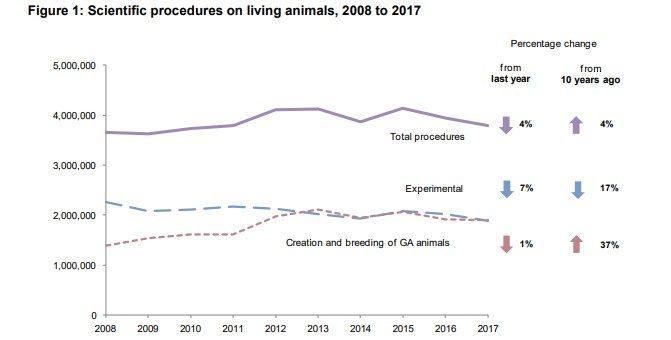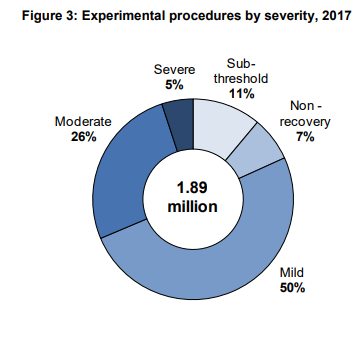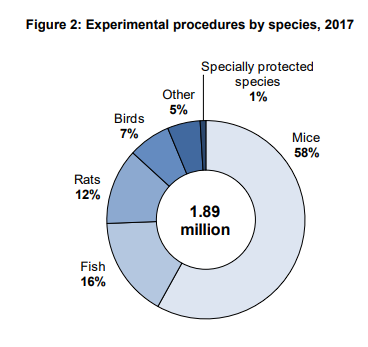Home Office reports use of animals in science statistics for 2017
Each year, the Home Office publishes statistics relating to regulated scientific procedures that are carried out on protected living animals in Great Britain. The reports give statistics on experimental procedures carried out on animals as well as on the creation and breeding of genetically altered animals. The report also covers what types of animals are used, and what quantities of each are used. You can read the full 2017 report here.
Some key definitions from the report:
- An experimental procedure involves the use of animals in scientific studies for purposes such as the research and development of treatments, surgical training or environmental research.
- Creation and breeding of genetically altered specimens refers to the breeding of animals whose genes have been altered. The animals created in this way are not themselves used for experimental procedures, but their offspring are.
- Severe is the maximum level of suffering experienced by an animal during the procedure
- A regulated procedure is any procedure applied to an animal for an experimental, educational or scientific purpose which may cause the animal pain, suffering, distress or lasting harm equivalent to, or higher than, that caused by the introduction of a needle in accordance with good veterinary practice.
Decrease in regulated procedures from 2016
In 2017, 3.79 million procedures were carried out that involved living animals in Great Britain. Half of these were experimental procedures, while the other half can be attributed to the creation and breeding of genetically altered specimens. This number is a decrease of 4% on 2016, and is the lowest number of procedures since 2010. The total number of procedures has risen by 4% over the past ten years, but this is attributed to a rise in the creation and breeding of genetically altered specimens rather than a rise in experimental procedures.

The proportions of species used for experimental procedures have remained stable for the past ten years, with mice, rats and fish the most commonly used in experimental procedures. There was an overall fall in procedures from 2016, and also a decrease of 10% in procedures involving mice. The proportion of experimental procedures involving fish increased by 8% from 2016.

In 2017, over three quarters of experimental procedure were assessed as being mild or moderate in their severity. The numbers for 2017 are in line with previous years.

Animals provide a crucial role in carrying out high quality research. The use of animals in the development of medicines is legally mandated, for researchers to assess the safety of medicines in advance of trials in humans. The BIA is a signatory of the Concordat on Openness on the Use of Animals in Research. This agreement is supported by a range of organisations – including universities, companies, research funders and umbrella organisations – to commit to being open about the use of animals in research in the UK. The UK continues to rank among the highest in the world for the welfare of animals used in research, and these statistics show that we are moving from strength-to-strength in this area.
.png)
.png)